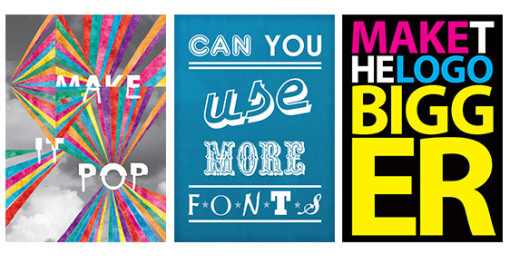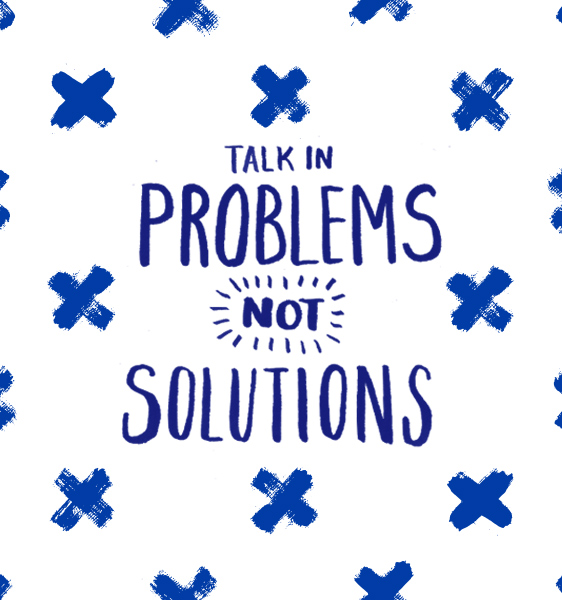3 simple tips for communicating actionable, honest, and objective feedback.
Gathering and implementing client feedback is a huge part of a designer’s job, but it can sometimes prove a frustrating process for both designer and client. The internet is filled with designer-made memes like this poster series capturing the creative community’s favorite worst feedback:
 While I come across so many thoughts for designers on how to “manage” client feedback, I rarely see anything that actually helps clients give better feedback. And so, I’ve decided to bridge the gap between client and creative. (Be the change, right?)
While I come across so many thoughts for designers on how to “manage” client feedback, I rarely see anything that actually helps clients give better feedback. And so, I’ve decided to bridge the gap between client and creative. (Be the change, right?)
Rule #1 | Talk in problems, not solutions.
This is the GOLDEN RULE. It is by far the MOST important thing you can do when giving feedback and one of the most encouraged practices in design.

Often out of good intention, we try to offer up solutions instead of describing everything we feel is wrong with a particular design. Instead of expressing why we feel the color choice isn’t working, we may propose a palette we think would work better. It reflects a polite way of collaborating—don’t talk about a problem if you can’t offer up a solution. But in visual design, this is actually very harmful to both the end design and the client-creative relationship.
Solution-focused feedback sounds like this:
“Make that bigger, all caps and red.”
Why? Because as a designer, I have no idea what the client feels is actually wrong with the design. If I don’t understand the problem, I can’t solve it.
Instead, problem-focused feedback sounds like this:
“I want to emphasize this information more; it doesn’t feel important enough.”
Tell the designer what the problem is and trust them to figure out how to solve it. Rather than simply pushing pixels, a strategic designer’s value is in their ability to make ‘big picture’ decisions and to think beyond what may seem obvious. Instead of making something “bigger” to appear more important, a designer might see an opportunity to adjust all of the other surrounding elements to be smaller and increase the overall visual contrast.
Rule #2 | Don’t throw the baby out with the bathwater.
While we just discussed the importance of talking about problems, we must also remember to communicate what is good or working well. Many times I’ve gone back and reworked for certain “problems” only to hear, “Wait, where did that icon go? I liked that treatment, why did we get rid of it?”
Assumptions are the death of design feedback. Always err on the side of over-communicating, rather than leaving it up to the client or creative to understand what you might be thinking or feeling. Start with what isn’t working but don’t forget about what is.

Rule #3 | Stay strategic.
Often when you’re so deep into round after round of revisions, paying close attention to all the little details of a project or design, you can easily lose sight of the objectives you began with. Make a point to always refer back to what the design or project was intended to do. This will not only ensure a strategic and clear design but it will also avoid subjective feedback. Everyone will be able to make informed judgements based on shared objectives, rather than personal tastes.

To help with this, I usually distill three concise ideas based on the strategic objectives of the project.
Here’s an example:
“The design needs to feel human, honest, and bold.”
You might start with a long list of what the objectives are and what the project or design should be. Then you must force yourself to identify the three MOST important ideas that will guide the creative thinking. This will create shared values, expectations and even a language around which you and your team can critique work effectively.
Why is good feedback important?
Time
Effective feedback will reduce the amount of back and forth between client and creative. You’ll get to the solution faster and by saving time, save money.
Better Design
The design, good or bad, is a reflection of the collaboration between the client and the creative. Better communication = better design.
 More than Sauce: Branding Diversity
More than Sauce: Branding Diversity  Talk to Me: Reading Out Loud as Part of the Writing Process
Talk to Me: Reading Out Loud as Part of the Writing Process  Getting the Most Out of Conferences
Getting the Most Out of Conferences